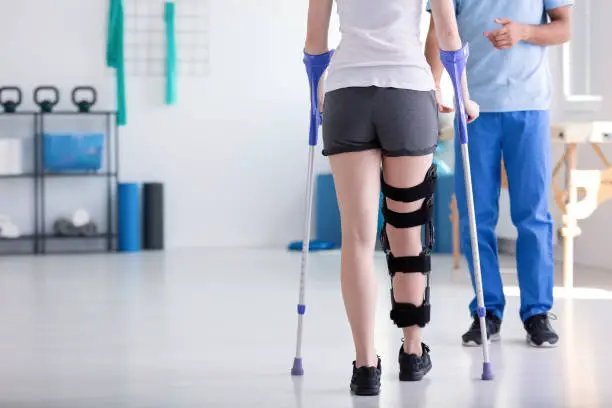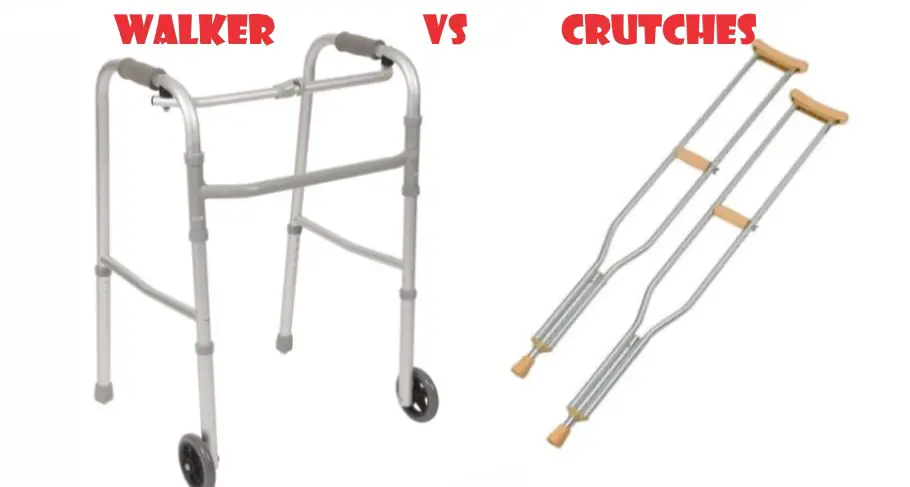Crutches are often used by patients with leg injuries.
The patient has to use the crutches for over 4 weeks to 6 months at times, depending on the severity of their condition. During that time, they are encouraged to be mobile and engage in their regular activities.
Using crutches requires strength and flexibility of the upper muscles to maneuver oneself.
This can make the muscles of the back and arms ache, even as you deal with the discomfort of the leg injury itself. It is, therefore, not surprising that patients get tired of using them over time.
This article will help to enlighten you on how to walk with crutches without getting tired.
Table of Contents
- Reasons Why You Might Get Tired While Walking with Crutches
- A Comprehensive Guide on How to Walk with Crutches Without Getting Tired
Reasons Why You Might Get Tired While Walking with Crutches
There are various reasons. But the two main reasons are:
1. Wrong sizing or fitting
As with other appliances, using crutches that are not your size or are not fitted to your height will only make walking with the crutches uncomfortable and tiring.
2. You don’t know how to properly walk with crutches
If you don’t know how to properly move around with the crutches, you might find that you get tired quite easily.
Related: How to Use Crutches on Stairs without Railing
A Comprehensive Guide on How to Walk with Crutches Without Getting Tired

1. Ensure that your crutches are built for comfort
Crutches are built for functionality, and so certain features like comfortability might be put into perspective, but minimally. Check the paddings on your crutches. Press your palms into the handrails and confirm that you’re comfortable with the feel and thickness.
Stand and press the crutches against the floor and check that the grip of the crutch tip – the part that touches the floor – is firm enough. This is especially important if you’re to wear your crutches for months.
If they wear out, you can always get new paddings and replace them.
2. Get your right size, then go get fitted
The size
Crutches are not a one-size-fits-all and usually come in categories for children, young adults, tall young adults, and adults. This can vary, depending on the model of the crutches. Get crutches in the category you fall into and take them for fittings.
Fitting your crutches
Typically, your physiotherapist should arrange for this to be done. But here are simple guidelines to follow in case you have to fit them yourself.
- Stand straight, relax your shoulders, and adjust the top of your crutches to fit just below your armpits, leaving about two fingers’ width – 1.5 to 2 inches – between your crutches and your armpits.
- Adjust the handrails till they are just at the level of the top of your hips. Then see if at this level, when you place your hands on the handrails, your elbows are a bit bent. If they are not, adjust it until it allows for a slight bend at your elbows.
A crutch that is too long or short for you makes you prone to accidents. If you master using a crutch that is inappropriately fitted for you, you will most likely have constant joint and muscle pains in your hands, back, and neck from trying to overcompensate.
Related: How to Carry Things with Crutches Seamlessly
3. Learn the right way or technique to move in crutches

Learning simple but effective techniques to properly move around with your crutches will significantly reduce your chances of getting tired while walking. When done properly, walking with crutches should soon feel as comfortable as when walking without them.
Weight-bearing
This is essential for every movement taken with the crutches. Your crutches stay under the armpit but should never be supported by them. Place your crutches against your sides and press your palms into the handrails.
This is where the bulk of your weight should be borne. Using your armpits could lead to damage of your upper limb nerves, causing far greater damage in the long run.
How to stand
Use the tripod position when standing with your crutches. To achieve this, place your crutches a little to the side and in front of your leg and stand on the good one, pressing your palms into the handrails for support.
Sitting or getting up from a chair
To sit on or stand up from a chair:
- Ensure that the chair is stable and has a firm footing
- Use one hand to hold both crutches at the handrails, placing the other hand on the arm of the chair for support
- Gently lower yourself into the chair or rise from it
Related: How to Easily Make Your Crutches More Comfortable (DIY Guide)
Walking
To properly walk using crutches:
- Start with the tripod position
- Move in short strides
- Place the crutches a few inches in front of you and slightly apart
- Swing the weak leg forward, resting solely on the handrails
- If your weak foot or leg is strictly non-weight bearing, keep it slightly raised even as you swing it forward
- Shift your good leg forward, placing it ahead of the crutches
- Placing your weight on the good leg, move your crutches forward again and follow with the weak leg
- Repeat the steps (3-6) until you reach your destination
Ascending and descending the stairs
The general rule for this is, ‘up with the good and down with the bad’. This simply helps you to remember to climb the steps with your good/uninjured leg first and descend the steps with your bad/injured leg first.
- Ascending
- Carry both crutches under one arm using their handrails
- Place the other hand on the stair rails
- Move forward with the good leg first, followed by the injured one
- Descending
- Place both crutches on the step in front of you
- Gently lower the injured leg on that step
- Quickly follow with the good leg
4. Seek comfort in your daily choices
While walking with crutches, it is important to ensure that all your choices are rooted in comfort as much as possible. Some tips include:
- Wear comfortable flats instead of heels
- Use lifts – if available – instead of the stairs
- Avoid running unnecessary errands
- Ask for help when you need it




